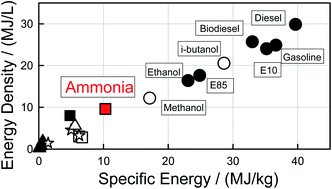Outlook for ammonia as a sustainable transportation fuel
Abstract
Recognition of the adverse impacts of climate change has led to interest in a transition to renewable, carbon-neutral energy and fuels. Ammonia has been proposed as a renewable transportation fuel, a medium for local energy storage, and a means for long-distance renewable energy transportation. We provide a perspective on the future use of ammonia as a transportation fuel. Ammonia poses health and safety concerns and ensuring safety for widespread distribution and consumer use would be challenging. Ammonia has a low energy content and is difficult to ignite, making it a relatively poor fuel in internal combustion engines. Engine unburnt ammonia emissions reported in the literature are approximately two to three orders of magnitude greater than Euro IV tailpipe limits and point to severe challenges in meeting emission regulations. Ammonia can be used in solid oxide fuel cells, but these operate at high temperatures (700–800 °C) and are not well suited for road vehicles. Proton exchange membrane and direct ammonia alkaline membrane fuel cell systems operate near room temperature and can use ammonia directly or indirectly (after conversion to H2) however poisoning and durability is problematic. Therefore, the expected use of ammonia as fuel for road transportation is very limited. With its low energy content, ammonia is not a viable aviation fuel. Substantial use of ammonia in rail applications seems unlikely given the advanced state of electrification and challenges associated with ammonia noted for road transport, many of which would also apply to rail. In contrast, the future use of ammonia as fuel in ocean-going ships seems feasible. Many large ports are already equipped to handle ammonia, storage volume and weight are not pressing issues for large ships, safety issues would be addressed with trained crews, and emission standards are less stringent. Ammonia might also find use as an energy carrier for transport of renewable energy between regions which would be a synergy with its use as a marine fuel.

- This article is part of the themed collection: Sustainable Energy and Fuels Recent Review Articles


 Please wait while we load your content...
Please wait while we load your content...